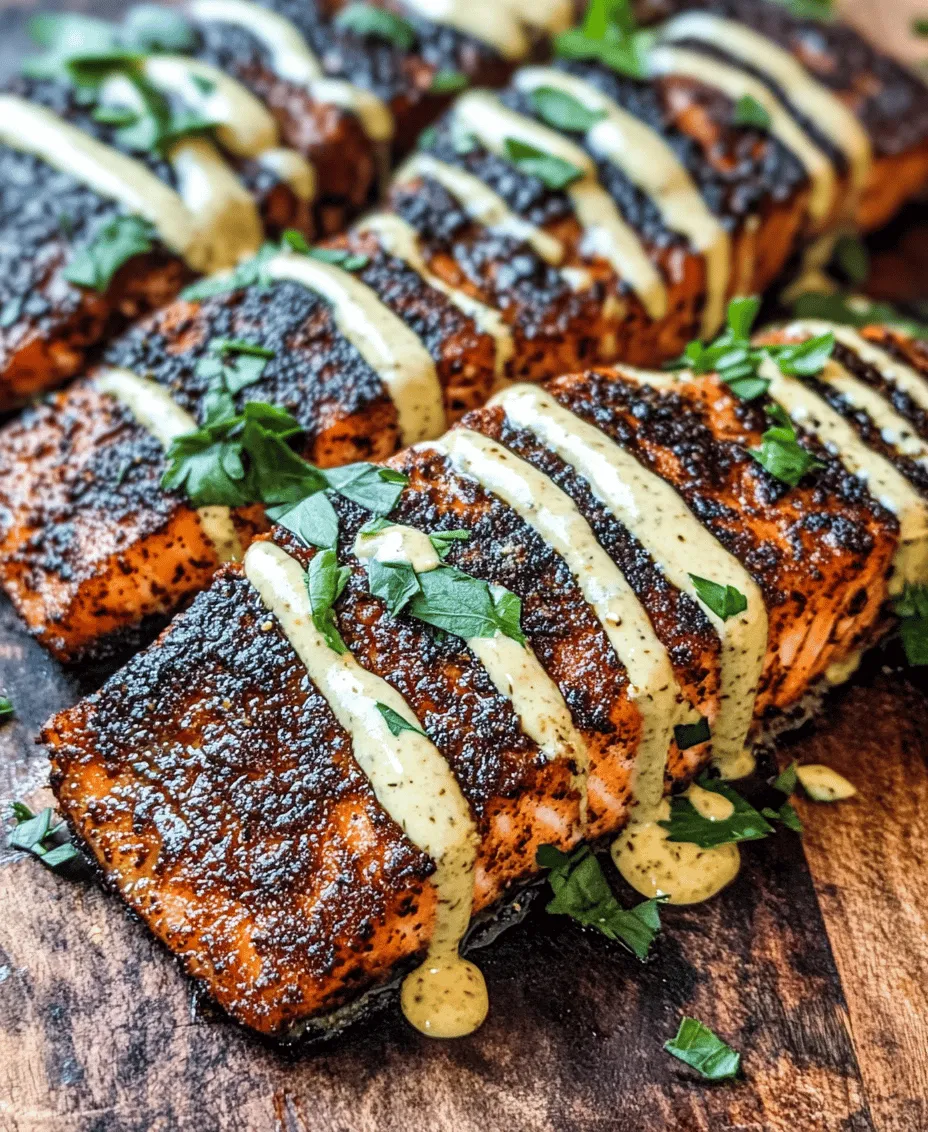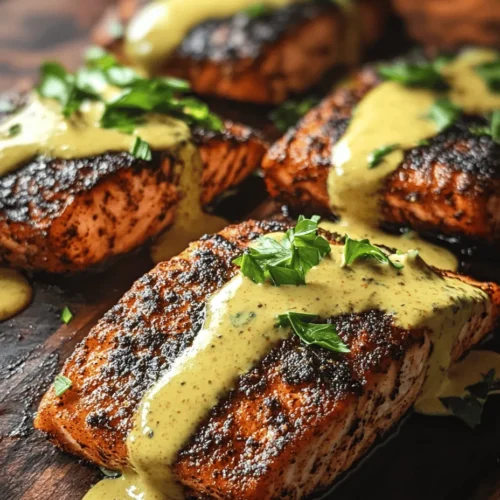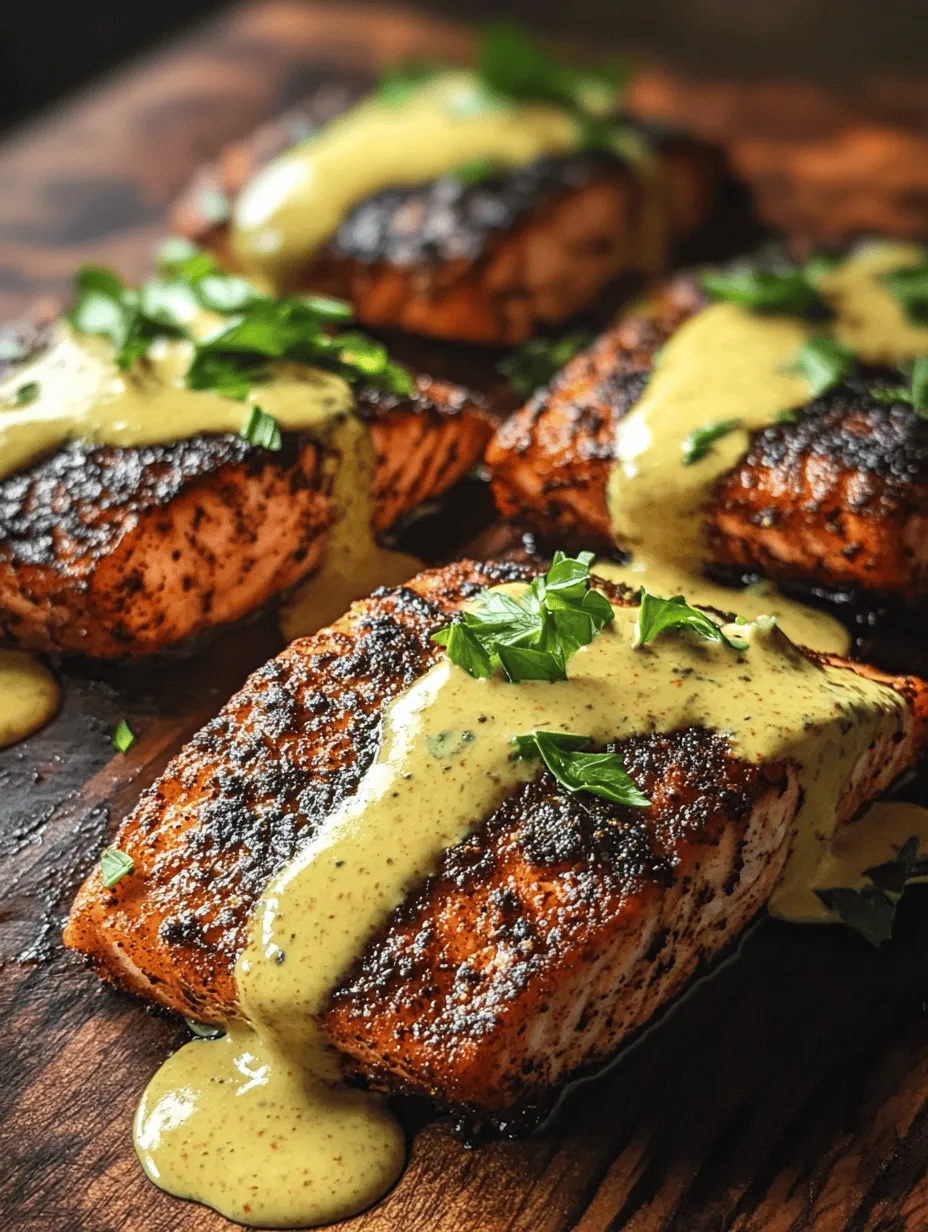Introduction
If you’re searching for a dish that is both delicious and nutritious, look no further than blackened salmon with creamy Dijon sauce. This culinary delight combines the rich, robust flavors of blackened seasoning with the creamy, tangy notes of a Dijon mustard sauce, creating an explosion of taste that is sure to impress. Whether you are a seafood lover or just looking to incorporate more healthy options into your diet, this recipe is an excellent choice. Salmon is not only flavorful but also packed with essential nutrients, making it a staple in many healthy eating plans.
In recent years, there has been a growing trend towards incorporating seafood into our meals, and for good reason. Seafood is often touted as one of the healthiest protein sources available. Not only does it provide high-quality protein, but it is also rich in omega-3 fatty acids, which are vital for heart health and cognitive function. By preparing salmon in this blackened style, you not only enhance its flavors but also make it a visually appealing centerpiece on your dinner table.
The unique flavor profile of blackened salmon is created through the use of a special spice blend that gives the fish its characteristic dark, crispy crust. Paired with a creamy Dijon sauce that balances the spice with a hint of tang, this dish is a perfect representation of how seafood can be both satisfying and health-conscious. So, let’s dive deeper into understanding blackened salmon and how to create this delectable dish at home.
Understanding Blackened Salmon
Definition of Blackening in Cooking
Blackening is a cooking technique that originated in the southern United States, particularly associated with Cajun cuisine. This method involves applying a blend of spices to fish (or other proteins) and then cooking it at high temperatures in a cast-iron skillet. The intense heat causes the spices to char and create a dark, crusty exterior while keeping the inside moist and tender. The result is a dish that boasts a bold flavor and an appealing texture.
Historical Background and Cultural Significance of Blackened Dishes
The blackening technique was popularized by renowned chef Paul Prudhomme in the 1980s, who introduced it to a broader audience through his restaurants and cookbooks. This cooking method not only showcases the rich flavors of Cajun cuisine but also reflects the cultural heritage of Louisiana, where flavors from various cultures converge. Blackened dishes have since become a staple in many households, appreciated for their ease of preparation and the depth of flavor they provide.
Nutritional Benefits of Salmon
Salmon is often celebrated as a superfood, and for good reason. It is an excellent source of high-quality protein, essential for muscle repair and growth, making it a favorite among fitness enthusiasts. Additionally, salmon is packed with omega-3 fatty acids, which have been linked to numerous health benefits, including reducing inflammation, lowering blood pressure, and supporting heart health. Furthermore, salmon is rich in vitamins B12 and D, selenium, and potassium, all of which contribute to overall health.
Incorporating blackened salmon into your diet is not only a delicious choice but also a smart one for your health. The balance of spices and the creamy sauce offers a delightful contrast that elevates the nutrient-dense fish, making it a fantastic option for meals throughout the week.
Ingredients Breakdown
Understanding the ingredients that go into blackened salmon with creamy Dijon sauce is essential to grasp the flavor profile and nutritional value of the dish.
Overview of Key Ingredients Used in the Recipe
The cornerstone of this dish is, of course, the salmon. However, the true magic lies in the blend of spices used for blackening, along with the creamy sauce that brings everything together. Here’s a closer look at the components that make this dish shine.
Importance of Fresh Salmon and How to Select Quality Fillets
When it comes to seafood, freshness is key. For this recipe, choose high-quality salmon fillets that have a bright color and firm texture. Look for fish that smells clean and ocean-like, rather than fishy. If possible, buy salmon from a reputable fishmonger who can provide insight into the sourcing and freshness of the fish. Wild-caught salmon is often considered superior in flavor and nutrition compared to farmed varieties, making it a preferred choice for many home cooks.
Explanation of Spices Used in the Blackened Seasoning
Blackened seasoning is a crucial element that defines the dish. Here are the primary spices that contribute to the robust flavor profile:
– Paprika: This spice adds both color and a mild sweetness to the dish. It’s usually the base of any blackening seasoning, providing a warm, rich backdrop for the more intense spices.
– Cayenne Pepper: Known for its heat, cayenne pepper not only brings spice to the dish but also offers health benefits. It can boost metabolism and aid in digestion, making it a wonderful addition to the seasoning blend.
– Garlic and Onion Powder: These flavor enhancers are staples in many spice blends and contribute to the overall savoriness of the blackened seasoning. They add depth and a hint of sweetness that balances the spiciness of cayenne.
– Thyme and Oregano: These herbs contribute herbal notes that complement the fish beautifully. Thyme adds earthiness, while oregano infuses a slightly peppery flavor, enhancing the complexity of the seasoning.
Heavy Cream and Dijon Mustard in the Sauce: Role and Flavor Contributions
The creamy Dijon sauce is what sets this dish apart and adds a luxurious texture that contrasts with the crispy salmon. Heavy cream adds richness, making the sauce velvety and smooth, while Dijon mustard introduces a tangy bite that cuts through the richness. The combination of these two ingredients creates a well-balanced sauce that elevates the dish to new heights.
Optional Garnishes: Fresh Parsley for Presentation
Presentation is key when serving any dish, and a sprinkle of fresh parsley brings a touch of color and freshness to the plate. Not only does it enhance the visual appeal, but it also adds a subtle herbal flavor that complements the richness of the salmon and sauce.
Preparation Process
Now that we have an understanding of the ingredients and their significance, let’s walk through the step-by-step process of preparing blackened salmon with creamy Dijon sauce.
Step-by-Step Guide to Preparing the Blackened Salmon
1. Gather Your Ingredients: Before you start cooking, ensure that you have all your ingredients ready. This includes your fresh salmon fillets, spices for the blackened seasoning, heavy cream, and Dijon mustard for the sauce.
2. Prepare the Blackened Seasoning: In a small bowl, combine the paprika, cayenne pepper, garlic powder, onion powder, thyme, and oregano. Mix well to ensure that the spices are evenly distributed. This blend will serve as the flavorful coating for your salmon.
3. Season the Salmon Fillets: Pat your salmon fillets dry with paper towels to remove any excess moisture. This step is crucial for achieving a good sear. Generously sprinkle the blackened seasoning over both sides of the fillets, pressing gently to help the spices adhere. Make sure to cover the salmon evenly for a consistent flavor throughout.
4. Heat the Skillet: Place a cast-iron skillet over medium-high heat and allow it to get hot. Once the skillet is hot, add a small amount of oil (such as vegetable or canola oil) to coat the bottom of the pan. You’ll want the skillet to be hot enough that the oil shimmers but does not smoke.
5. Cook the Salmon: Carefully place the seasoned salmon fillets in the skillet, skin-side down if applicable. Cook for about 4-5 minutes on the first side without moving them, allowing the spices to blacken and form a crust. Once the salmon easily releases from the skillet, flip the fillets and cook for another 3-4 minutes, depending on the thickness of the fish and your desired doneness.
By following these steps, you will achieve perfectly blackened salmon with a beautifully charred exterior and a tender, moist interior. The next phase of this culinary journey involves creating the creamy Dijon sauce that will elevate your dish to gourmet status. Stay tuned for the continuation of this recipe as we explore the sauce-making process and how to serve your blackened salmon for the ultimate dining experience.

Cooking Methods: Importance of Skillet Temperature and Timing
When it comes to cooking blackened salmon, mastering the skillet temperature and timing is crucial for achieving that signature char while keeping the fish moist and flaky. Start by preheating your skillet over medium-high heat. It’s essential to use a heavy-bottomed skillet, preferably cast iron, to ensure even heat distribution. The pan should be hot enough that when you add the salmon, it sizzles immediately.
Timing is another critical factor. Salmon fillets typically require about 3-4 minutes of cooking time per side, depending on the thickness of the fillet. For optimal results, watch for visual cues: the salmon should be cooked until it is opaque and the edges start to flake. For those who enjoy crispy skin, place the skin side down first, allowing it to get golden brown and crunchy before flipping. Be mindful not to overcrowd the pan, as this can lower the temperature and result in steaming rather than searing.
Visual Cues for Doneness and Skin Crispiness
Knowing when your salmon is done can be somewhat subjective, but there are reliable visual cues to guide you. The ideal doneness for salmon is medium, which means the fish should still be slightly translucent in the center. Look for the flesh to change from a shiny, raw appearance to a matte finish. The edges of the fillet will begin to flake easily when it’s cooked properly.
For those who prefer crispy skin, pay close attention to the texture. The skin should turn a deep golden brown and be firm to the touch. If the skin starts to curl or lift away from the fillet, it’s a sign that it’s time to flip. If you’re unsure, you can always use an instant-read thermometer—salmon is perfectly cooked when it reaches an internal temperature of 145°F (63°C).
Crafting the Creamy Dijon Sauce
Creating the creamy Dijon sauce to accompany your blackened salmon is a simple yet rewarding process. Start by gathering your ingredients: Dijon mustard, mayonnaise, a splash of lemon juice, and a bit of honey for sweetness.
To combine these ingredients effectively, use a small mixing bowl. Begin by whisking the mayonnaise and Dijon mustard together until smooth. The ratio can be adjusted based on your taste preferences—if you prefer a stronger mustard flavor, increase the Dijon proportion. Next, add a splash of lemon juice to brighten the sauce, followed by honey to balance the tanginess. Whisk together until the sauce has a creamy consistency without any lumps.
For those who enjoy a bit more texture, consider adding finely chopped fresh herbs like dill or chives. This not only enhances the flavor but also adds a pop of color to your dish.
Tips for Adjusting Sauce Thickness and Flavor
If you find that your sauce is too thick, you can easily adjust the consistency by adding a teaspoon of water or extra lemon juice. For a thinner sauce, continue to mix until the desired thickness is achieved. Conversely, if your sauce is too thin, simply add a bit more mayonnaise or Dijon mustard until you reach the right texture.
Flavor adjustments can also be made to tailor the sauce to your preferences. For a spicier kick, mix in a dash of hot sauce or a pinch of cayenne pepper. Alternatively, for a more robust flavor, consider adding minced garlic or shallots. The beauty of this sauce is its versatility; don’t hesitate to experiment and make it your own.
Serving Suggestions
When it comes to serving your blackened salmon, the options are plentiful. Consider pairing it with side dishes that complement the rich, smoky flavors of the fish.
Fresh Salads for a Light Pairing: A light, refreshing salad can balance the richness of the salmon. A simple arugula salad with cherry tomatoes, cucumber, and a light vinaigrette works wonderfully. Alternatively, a citrus salad featuring segments of orange and grapefruit can add a zesty contrast.
Roasted Vegetables to Enhance the Meal: Roasted vegetables are an excellent choice for adding heartiness to your plate. Try roasting seasonal vegetables like asparagus, bell peppers, or Brussels sprouts with olive oil, salt, and pepper until they are caramelized and tender.
Grain Options: Rice or Quinoa for a Hearty Addition: For a more filling meal, consider serving your blackened salmon over a bed of grains like rice or quinoa. You can prepare a simple lemon-infused quinoa or a pilaf with herbs to complement the dish beautifully.
Presentation Tips: Plating the Dish to Enhance Visual Appeal: When plating, consider the use of contrasting colors to make the dish visually appealing. Place the salmon on a bed of greens or grains, and drizzle the creamy Dijon sauce artfully across the top. Garnish with fresh herbs for an extra touch of elegance.
Health Benefits of Blackened Salmon
Blackened salmon is not only delicious but also packed with health benefits. Salmon is rich in omega-3 fatty acids, which are essential for heart health and brain function. These healthy fats can help reduce inflammation and lower the risk of chronic diseases. Additionally, salmon is an excellent source of high-quality protein, making it a perfect choice for those looking to maintain muscle mass while enjoying a nutrient-dense meal.
The spices used in blackening also bring their own health benefits. Paprika, cayenne pepper, and garlic not only enhance flavor but also contain antioxidants and anti-inflammatory properties. Incorporating these spices into your diet can contribute to overall health and well-being.
This dish fits seamlessly into a balanced diet. Paired with vegetables and whole grains, blackened salmon provides a well-rounded meal that is satisfying and nutritious.
Variations and Customizations
One of the joys of cooking is the ability to customize recipes to fit your tastes. For this blackened salmon dish, consider altering the spice blend to explore different flavor profiles. For a milder version, reduce the cayenne pepper or substitute with smoked paprika for a smoky flavor without the heat.
If you’re looking for alternatives to salmon, many other fish work well with this cooking method. Try using tilapia, sea bass, or even chicken breast if you prefer poultry. For a plant-based option, consider marinated tofu or tempeh, which can absorb the spices beautifully and provide a satisfying texture.
Additionally, you can modify the creamy Dijon sauce to accommodate dietary preferences. For a dairy-free version, substitute the mayonnaise with an avocado-based or vegan mayonnaise. If you’re aiming for a lower-fat option, Greek yogurt can be used instead of mayonnaise to maintain creaminess while reducing calories.
Conclusion
In summary, blackened salmon with creamy Dijon sauce is a delectable meal that combines bold flavors with numerous health benefits. This dish not only satisfies the palate but also nourishes the body, making it an excellent choice for any dinner table.
We encourage you to try this recipe and make it your own—experiment with different spices and sides to create a meal that reflects your personal taste. Embrace the joy of homemade cooking, as it allows you to control the ingredients while enjoying the process of preparing a meal from scratch. Enjoy the delightful experience of savoring a nutritious, flavorful dish that you’ve created with your own hands.



